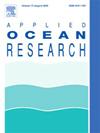倾斜水射流平移引起粘性土壤侵蚀的试验研究
IF 4.3
2区 工程技术
Q1 ENGINEERING, OCEAN
引用次数: 0
摘要
尽管水下倾斜水射流用于海底工程(如疏浚、挖沟和深海采矿),但对水下倾斜水射流造成的沉积物侵蚀进行的研究非常有限。为此,我们开展了一组新颖的小尺度实验,初步研究了射流倾角对粘性泥沙侵蚀的影响。实验结果表明,垂直射流对最大空腔深度(或“侵蚀深度”)有影响,但对最大空腔尺寸(产沙量)没有影响。冲蚀深度随着喷射角的增大而增大,在90°处达到最大值,然后随着喷射角的进一步增大而减小。结果还表明,空腔宽度(或“侵蚀宽度”)不一定与撞击区域相关,而是与侵蚀有效射流宽度相关,射流宽度是流速高到足以穿透床层的射流宽度。对空腔尺寸的分析表明,在25°、45°、65°、90°、115°、135°和155°的测试射流角度中,65°射流角度产沙量最大。发现侵蚀深度与水流对粘土的冲击力成正比。本文章由计算机程序翻译,如有差异,请以英文原文为准。
Experimental investigation of cohesive soil erosion caused by translating submerged inclined water jets
Very limited research has been carried out to investigate sediment erosion caused by subaqueous inclined water jets, despite the fact that such water jets are used in subsea engineering (e.g., dredging, trenching, and deep sea mining). Therefore, we conducted a set of novel small-scale experiments to primarily study the effect of jetting inclination on cohesive sediment erosion. The experimental results reveal that vertical jetting results in the largest cavity depth (or ’erosion depth’), but not in the largest cavity size (sediment production). The erosion depth increases with the jetting angle reaching its maximum at 90° and then begins to decrease with further increase in the jetting angle. The results also indicate that the cavity width (or ’erosion width’) is not necessarily correlated with the impingement region but is instead associated with the erosion-effective jet width—the width of the jet where flow velocities are high enough to penetrate the bed. Analysis of the cavity size showed that the largest sediment production was achieved at a 65° jetting angle among the tested jetting angles (25 °, 45 °, 65 °, 90 °, 115 °, 135 °, and 155 °). The erosion depth was found to be highly proportional to the impingement force exerted by the flow on the clay.
求助全文
通过发布文献求助,成功后即可免费获取论文全文。
去求助
来源期刊

Applied Ocean Research
地学-工程:大洋
CiteScore
8.70
自引率
7.00%
发文量
316
审稿时长
59 days
期刊介绍:
The aim of Applied Ocean Research is to encourage the submission of papers that advance the state of knowledge in a range of topics relevant to ocean engineering.
 求助内容:
求助内容: 应助结果提醒方式:
应助结果提醒方式:


